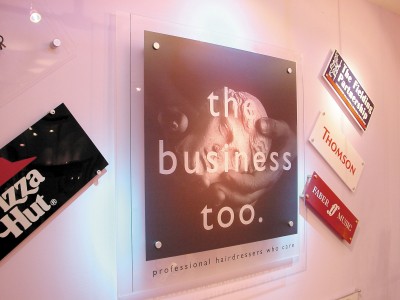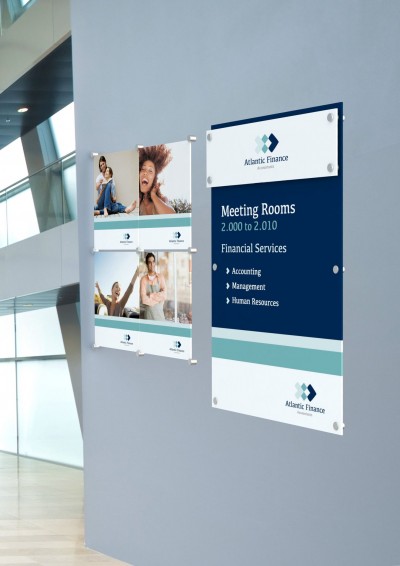Another advantage for sign installers is not having to work with a screwdriver down a long barrel, where it is very difficult to see what is happening. This type of fixture is particularly useful when working on a ladder.
On some larger-diameter fittings, there is a special added ‘lip.’ This is a significant asset for an individual installer when fixing a large sign panel into place, as the lip acts as a panel locator and stops the panel from sliding down. This type of standoff will typically hold panels up to 20 mm (0.79 in.) thick.
Smaller two-part fixtures are ideal for attaching standoffs directly to wooden display panels or doors. Their hole size may vary, but normally will accommodate screw threads from 3.5 to 4.2 mm (0.14 to 0.16 in.) in diameter (i.e. #6 to #8 screws).
While the majority of panels and acrylic poster holders are mounted to walls by use of their panel holes, some standoff manufacturers provide plastic washers that can be inserted directly into fixtures, such that small signs do not need holes at all. These can be extremely useful for quick installations.
Suspension systems
Suspended cable or rod systems provide much more flexibility when installing signs. Unlike standoffs, they do not require a completely flat wall. Indeed, they do not need a wall at all.
With these systems, signs can be suspended from the ceiling, fixed between the floor and the ceiling or mounted to either a flat or curved wall. While a fixed sign must remain in place (and can leave behind an ugly hole in the wall after it is removed), a suspended sign can be positioned at any height along its vertical cables or rods.
A hanging sign can certainly be achieved with small standoffs and a ‘jaw’ clamp from the ceiling, but often the ceiling is too high for such a setup. Instead, the better option is to suspend a thin-diameter cable or rod from the ceiling. Double-sided signs can be clamped from the side, while single-sided signs can have holes drilled through, such that the rods go down the back and are held in place by studs in the front. Signs can be mounted one under the other, as the system ensures everything hangs straight, no matter each sign’s shape or size.

Since standoffs hold signs away from the wall, any dust gathering on that wall will drop down behind, helping them to remain clean in appearance.
Labour costs are reduced with these types of systems, as it is much quicker and easier to put up multiple signs along a cable or rod system than it is to drill holes in a wall for each individual sign. Rods are typically available in several thicknesses—e.g. 3, 6 and 10 mm (0.12, 0.24 and 0.39 in.)—and a wider variety of lengths.
The design of the clamps or panel supports can be specified to match the appearance of standoffs, so a sign system can feature a totally integrated colour scheme. And like the standoffs, suspended signs can be fixed into place with an Allen key, which makes adjustments sufficiently easy for the client’s office staff or retail employees to handle in-house.
In cases where sign information is constantly being changed, one option is an acrylic pocket that allows graphics to be dropped into place, without the need for any tools. The less expensive it is to change a sign, the more opportunities there are for clients to use it as part of their business.
A directory, for example, could be installed with 6-mm (0.24-in.) diameter rods mounted to a wall or suspended in the centre of an open space. It could be single- or double-sided. Its individual sign panels could be mounted above and underneath each other, with no restrictions on panel height, so the header and footer panels might be larger than the others.
This type of directory is a good example of a system that is easy to update with the addition of new signs in the future. For clients who need signage to direct their visitors to different rooms and departments, they have a lot of flexibility to make such changes.






